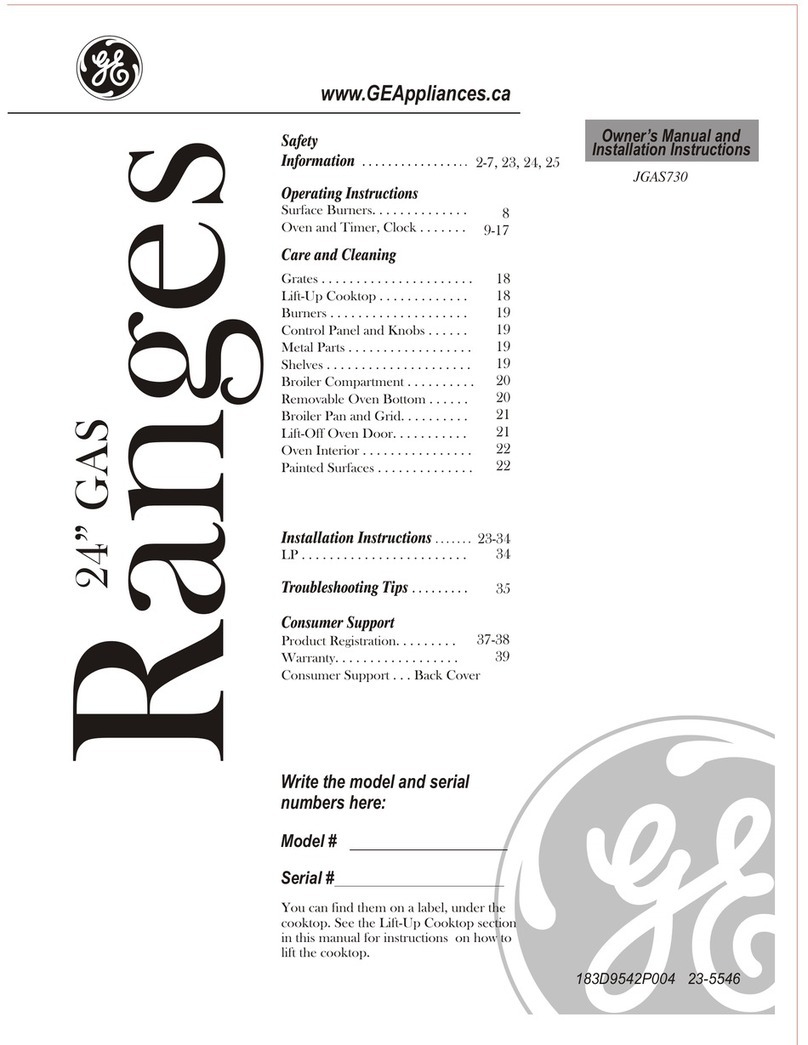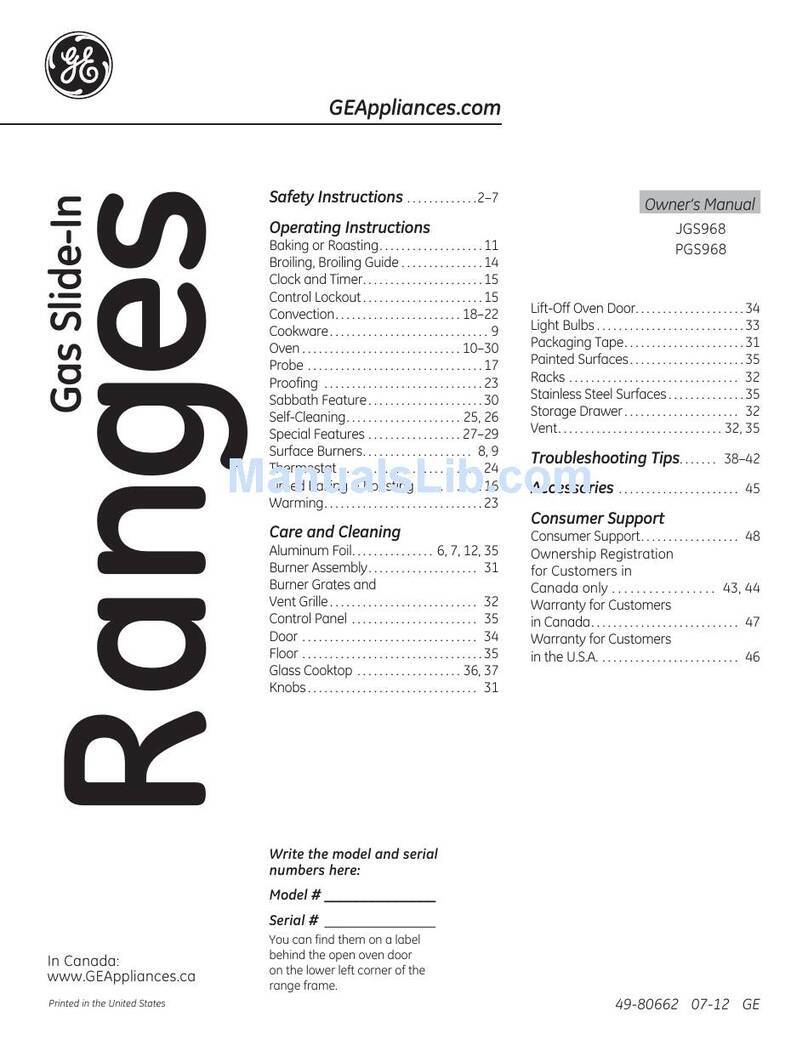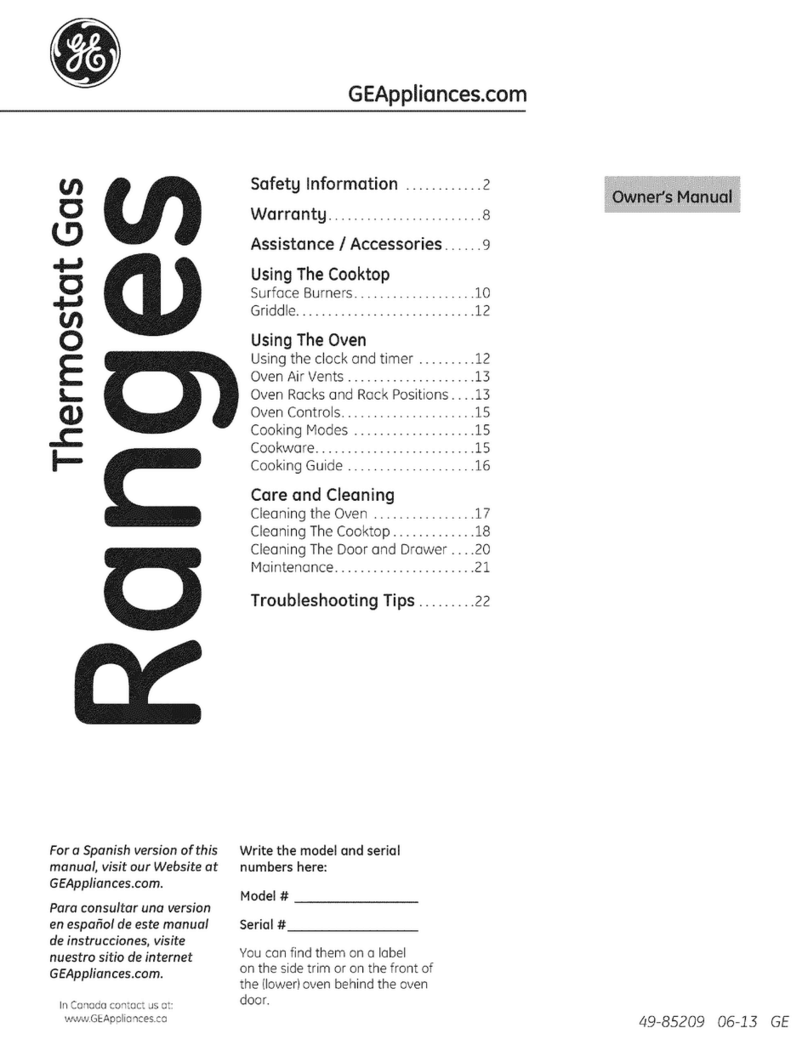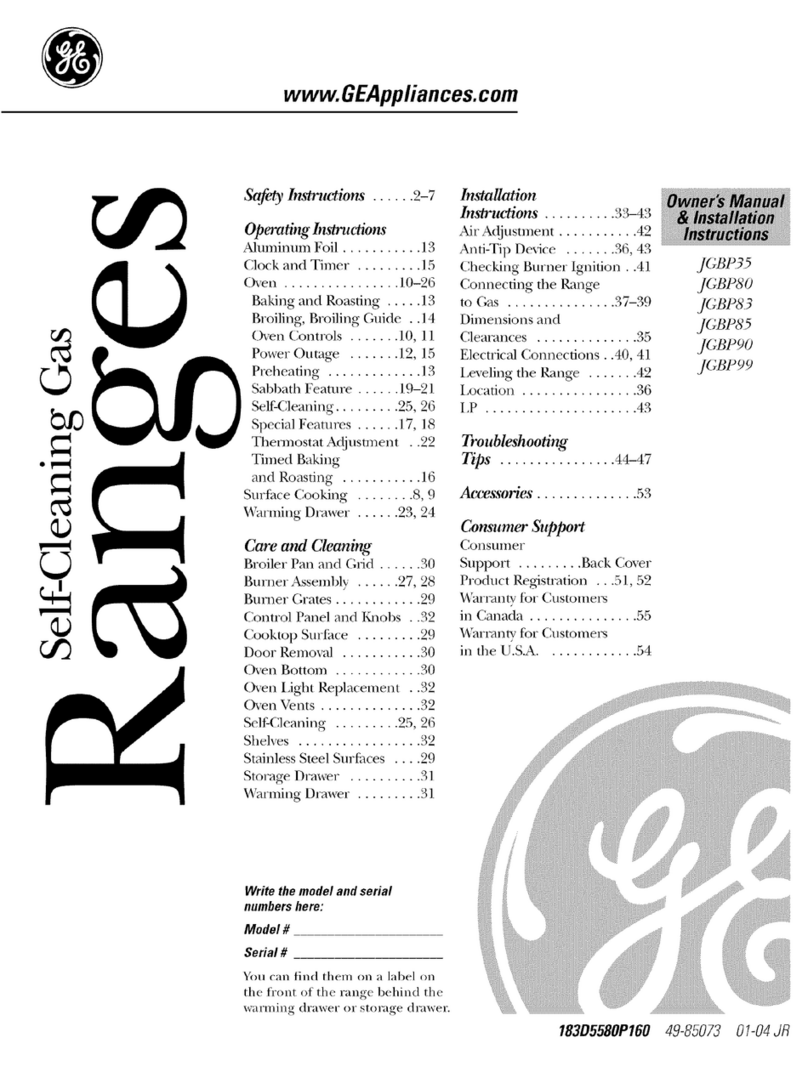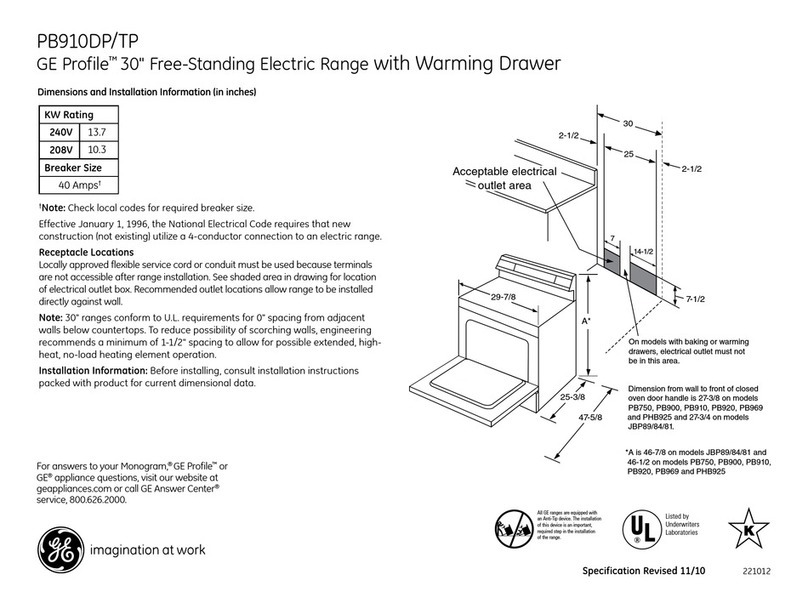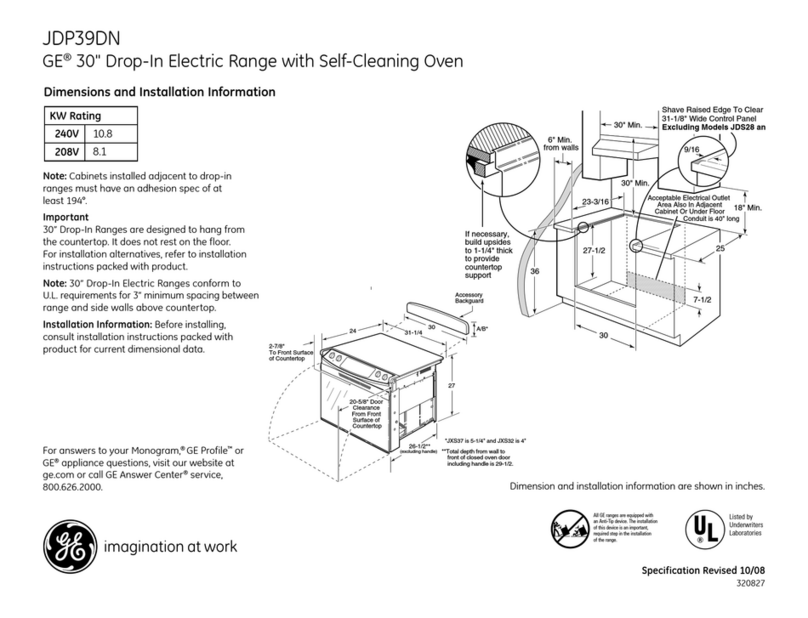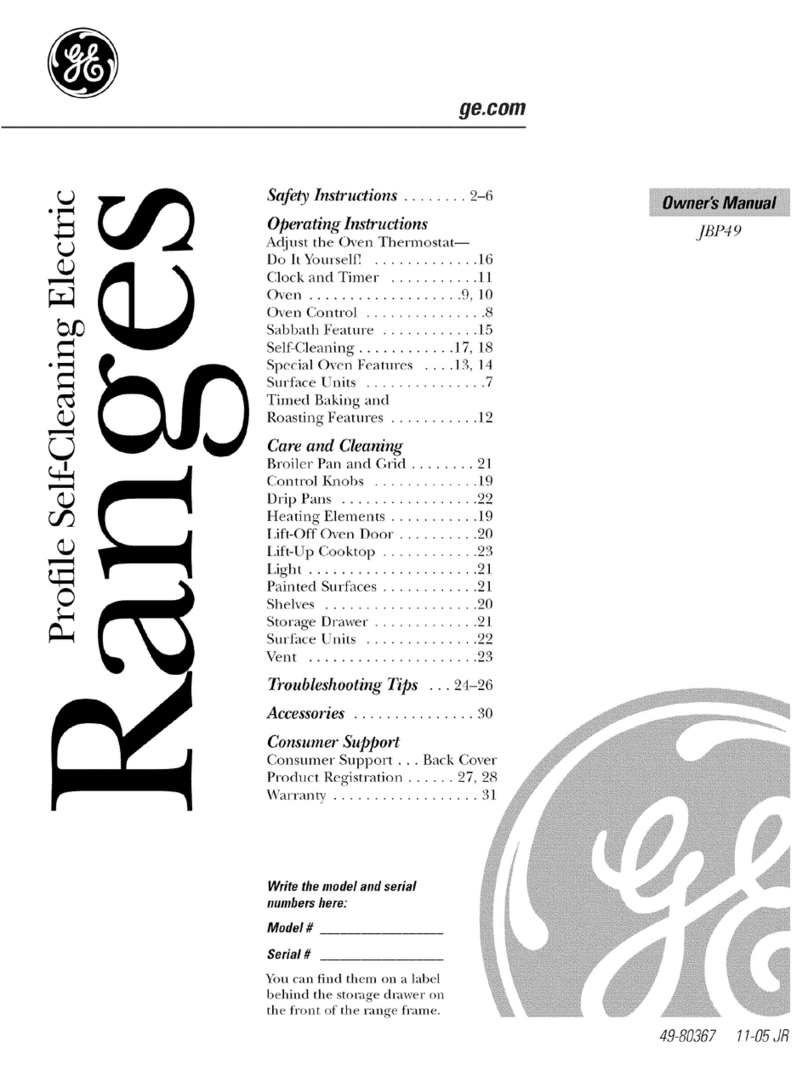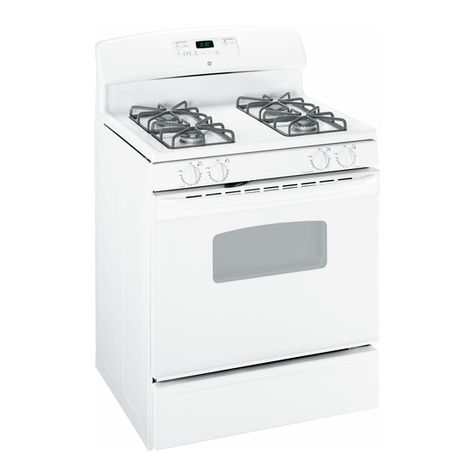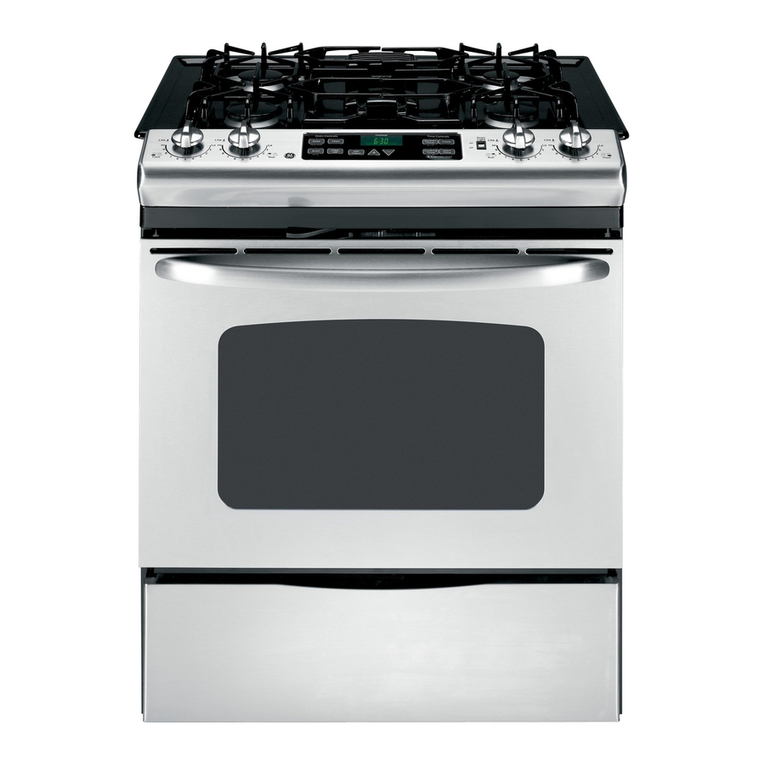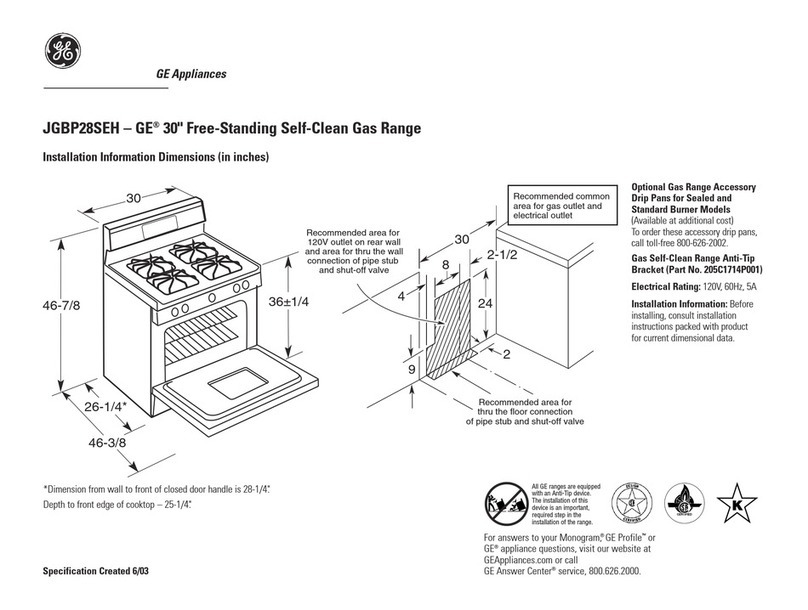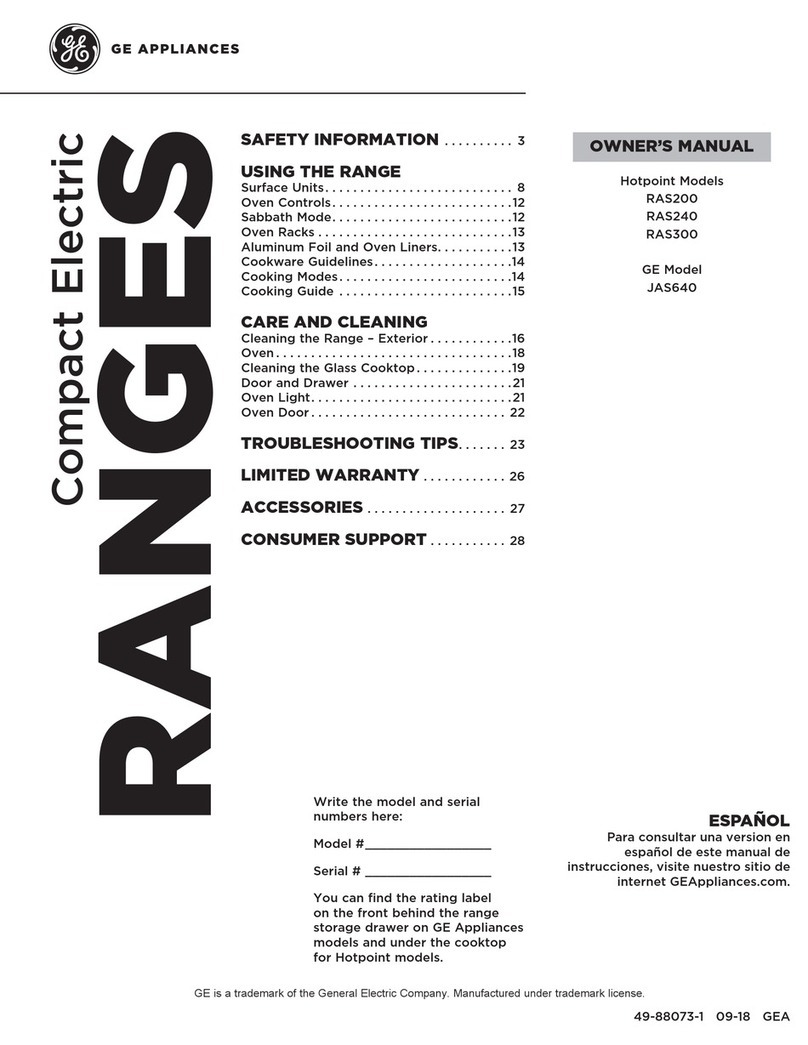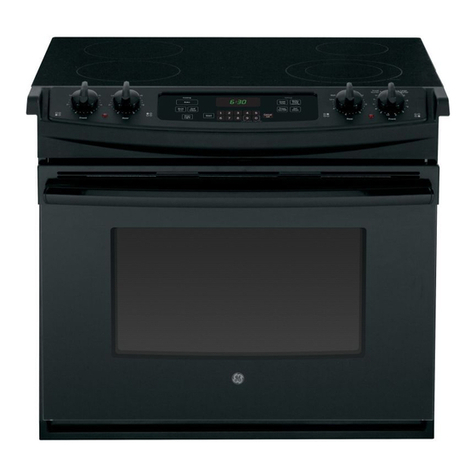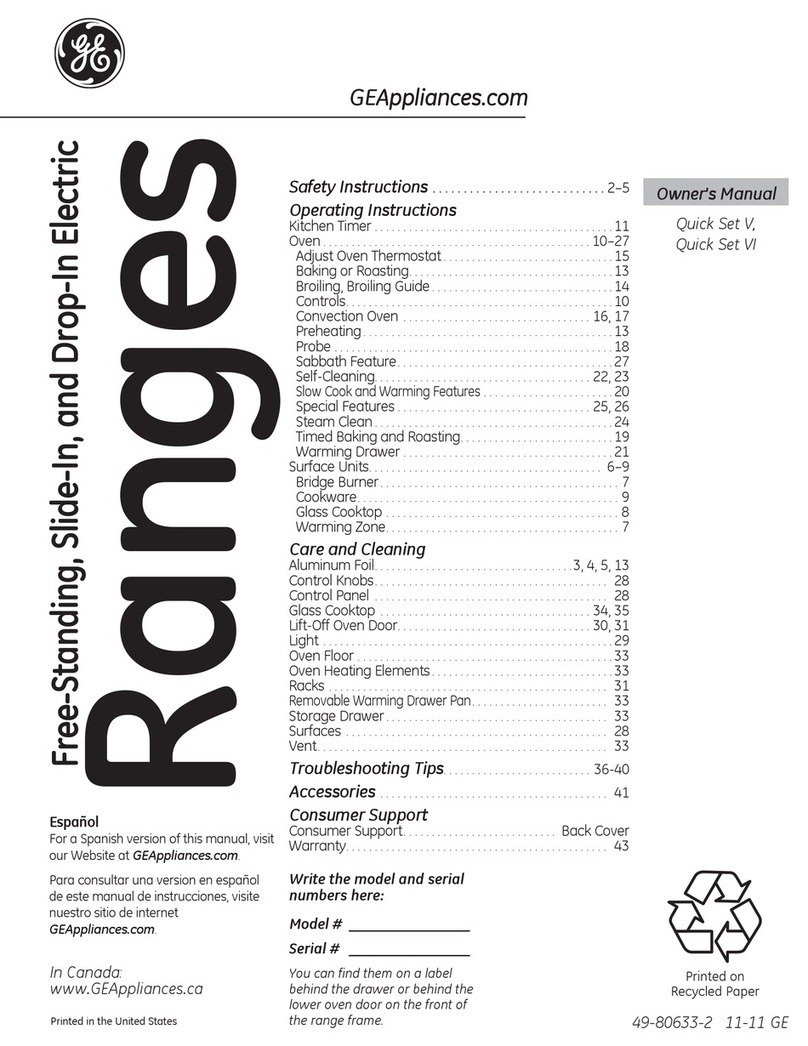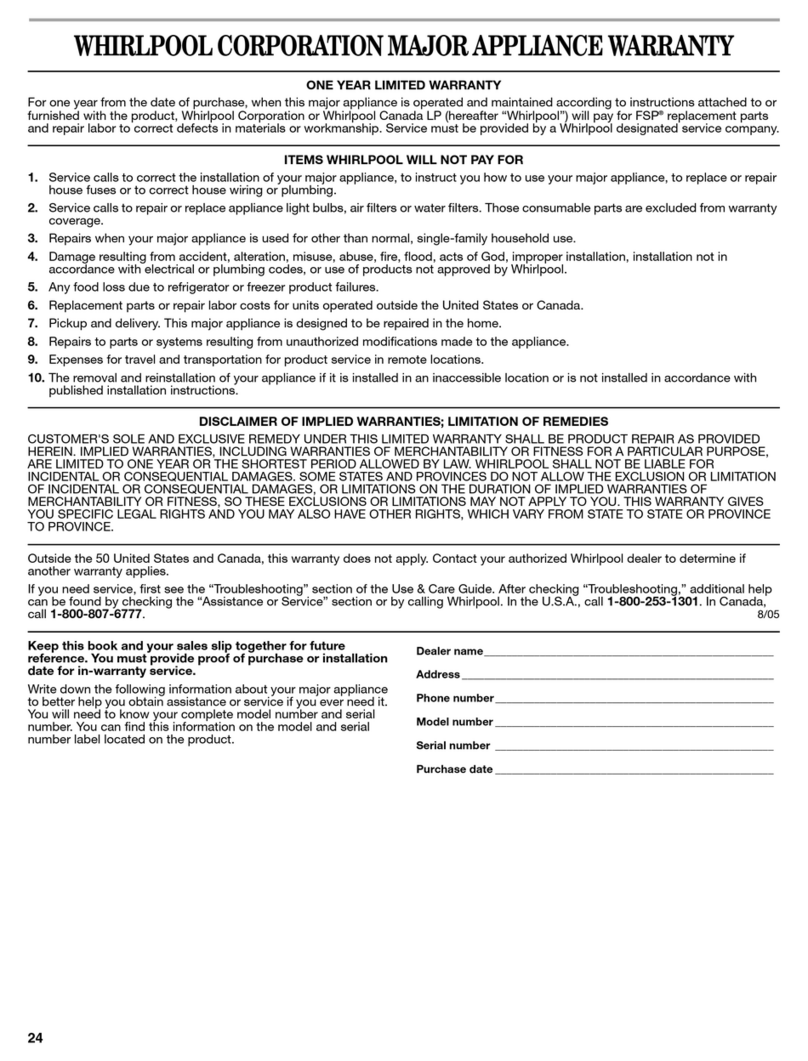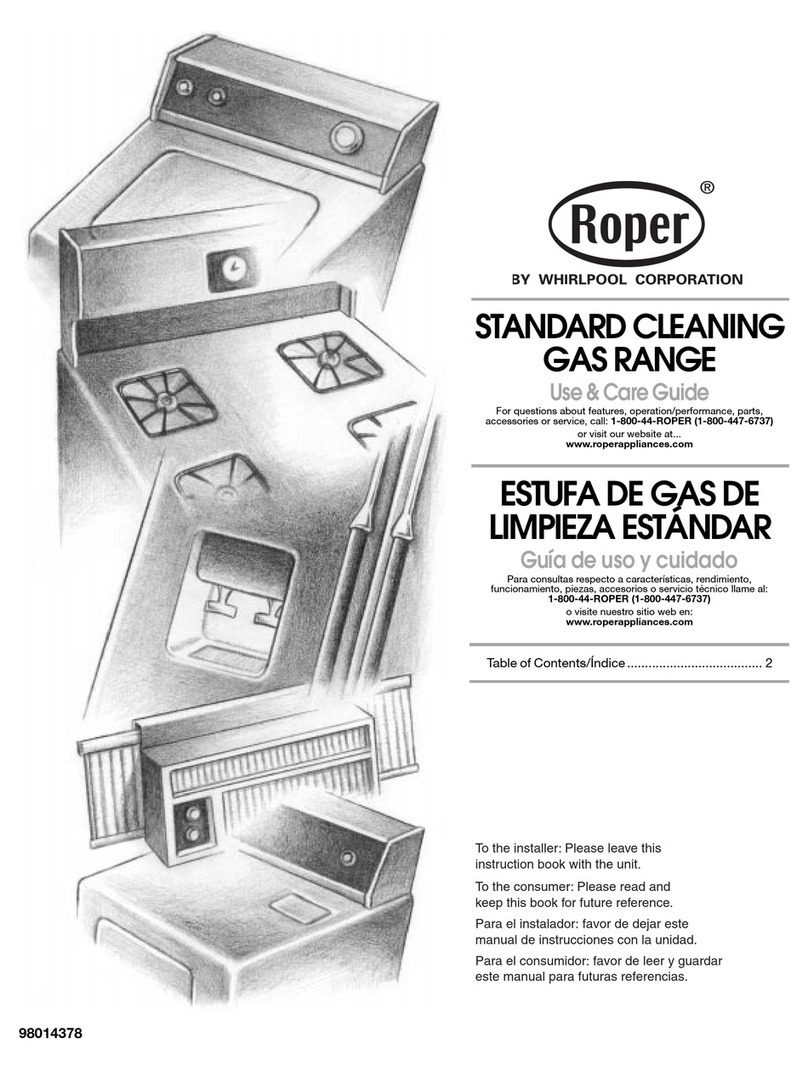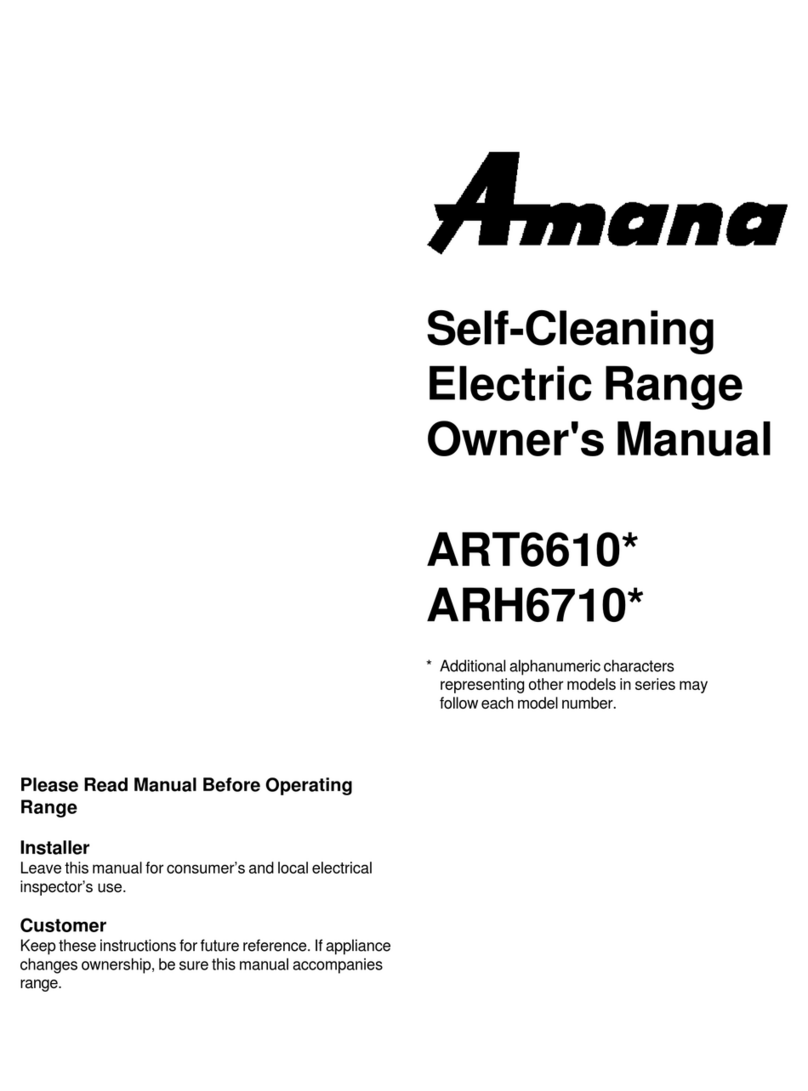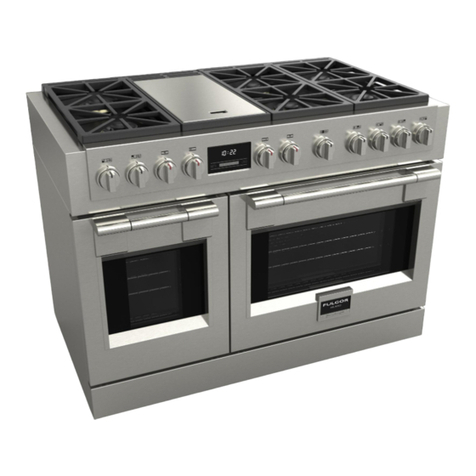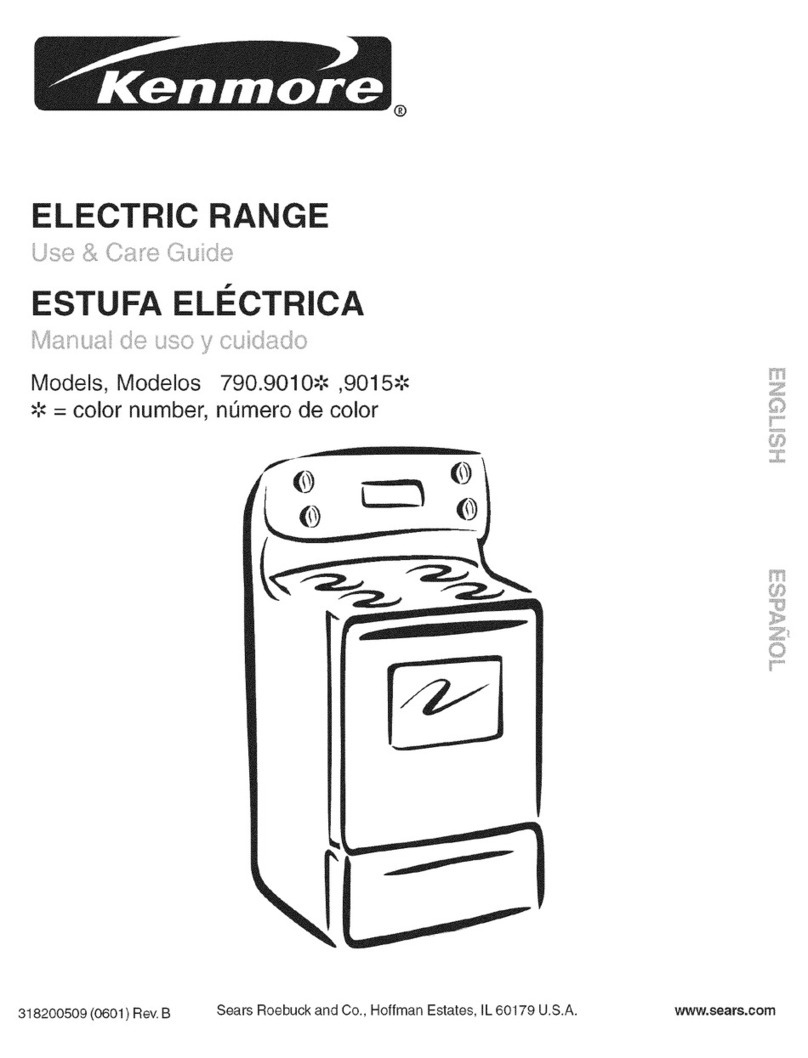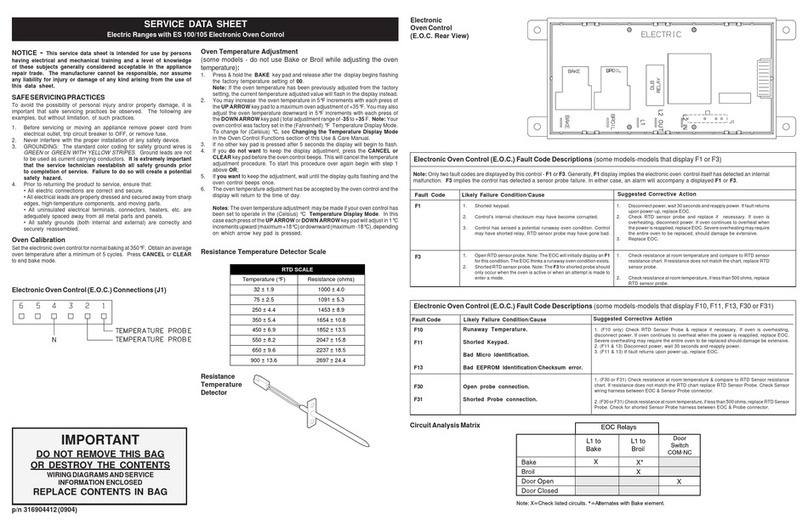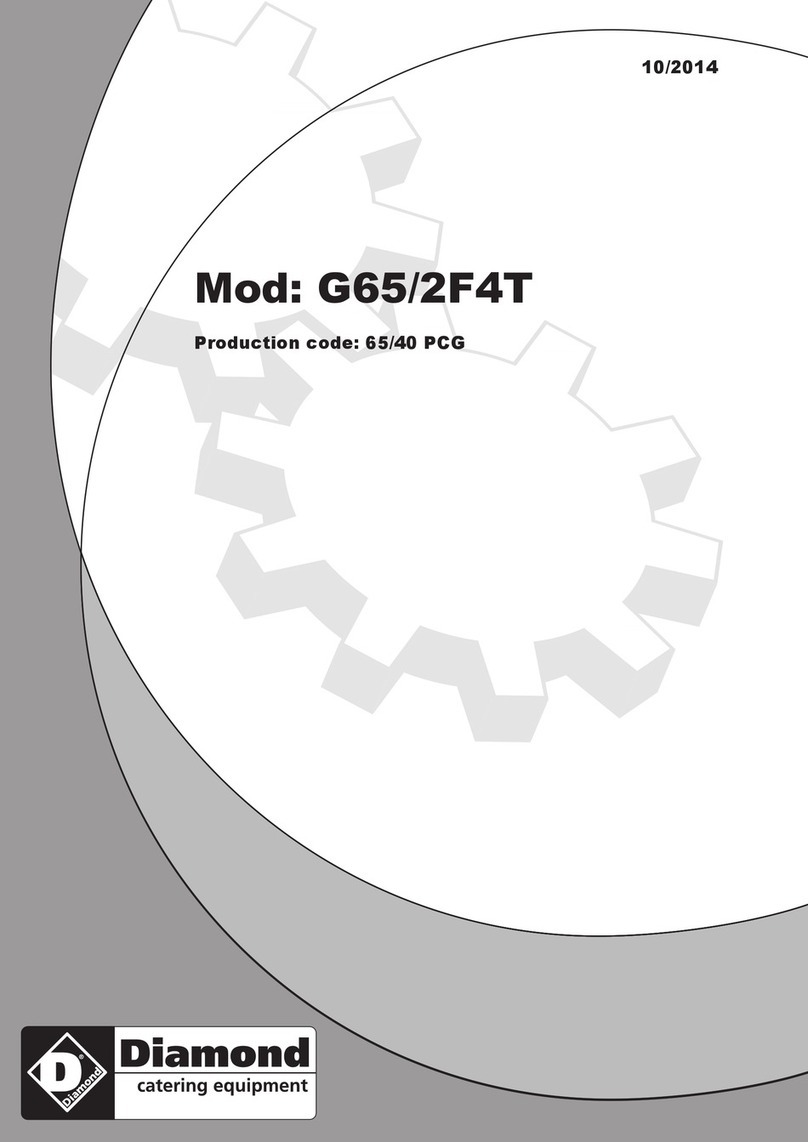lnstrucciones de instalaci6n
Cocinas elactricas independientes
_Preguntas? Llame a) !.800.GE.CARES(!.800.432.2737) o visite www.GEApp)iances.com
En Canada, Ilame al 1.800.561.3344 o visite www.GEAppliances.ca
ANTES DE COMENZAR
Lea estas instrucdones par completo y con
detenimiento.
" IMPORTANTE -- Guarde estas
instrucciones para el usa de inspectores
locales.
" IMPORTANTE -- Sigatodos
los c6digos y ordenanzas vigentes.
, Nota al instalador - Aseg0rese de dejar estas
instrucciones con el consumidor.
, Nota al consumidor - Conserve estas
instrucdones para referencia futura.
, Nivel de destreza - La instalaci6n de este
aparato debe efectuarla un instalador o
electricista caJificado.
. Elinstalador tiene la responsabilidad
de efectuar una instalad6n adecuada.
• Lagarant[a no cubre lasfolios del producto
debido a una instalaci6n incorrecta.
PARA SU SEGURIDAD
! A _ A
Riesqo de Caida
• Un nifio o adulto pueden volcar la cocina y morir.
• Instale el soporte anti-volcaduras sabre la pared o
el piso.
• Adhiera la estufa al soporte anti-volcaduras, volviendo
a deslizar la estufa de modo que el pie quede adherido.
• Vuelva a adherir el soporte anti-volcaduras si la estufa
se mueve de lugar.
• Si esto no se hace, se podr6 producir la muerte o
quemaduras graves en nifios o adultos.
Sino recibi6 un soporte anti volcaduras con su compra,
Ilame al 1.800.626.8774 para recibir uno sin costa.
(EnCanada, Ilame al !.800.56!.3344). Para recibir
instrucciones de instalaci6n del soporte, visite:
GEAppliances.com(EnCanada, GEAppliances.ca.).
Kit de soporte
anti volcaduras incluido
,_ ADVERTENCtA -- Antes
de comenzar la instalaci6n, apague el
encendido en el panel de servicio ybloquee
el media de desconexi6n del servicio a fin de
evitar que el encendido se active de forma
accidental. Cuando el media de desconexi6n
del servicio no se pueda bloquear, ajuste
de manera segura un item de advertencia
que est4 bien visible, tal coma una etiqueta,
sabre el panel de servicio.
MATERIALES QUE PUEDE NECESITAR
Conector de presian
(S6topara instalaciones
con conductos
portacables)
(AprobadosparULde 40 AMP)
Cablede 4abmbres de4'
de largoO Cablede 3 alambres
de 4' de largo
HERRAHIENTAS NECESARIAS
Perforadora con hojalata
broca de 1/8" Cinta m4trica
Gafas de seguridad Alicates
Llave ajustable Llave de tuercas
Nivel de i/4"
TUeras para
|QUITE LOS MATERIALES DE ENV/O: Noquitarlos materiales
de empaque puede provocar daflos al electrodom#stico. Quite todas las partes de empaque del
homo, bandejas, elementos calentadores y caj6n. Tambian, quite la pelfcula protectora y las
etiquetas de la puerta exterior, estufa, y panel de control.
121 C6MO PREPARARLA ABERTURA(PARAUSOENINTERIORESSOLAMENTE)
Ver ilustraciones con todas los dimensiones de empotrado y de espacio. Lacocina puede ubicarse con un
espacio de 0" (alineado) sabre la pared trasera ylos paredes laterales del gabinete.
I'" 30" j
i
iInstale la caja de distribuci6n
sabre cualquier lado de
la linea central.
.29_/8 "
36_,J' 46Y_"
+/-Y4"
26"_
z \_,. 46"
* Los modelos de marca GE "_
cuentan con paneles de
control de un ancho
de 30 7/8".
La electricidad hacia la cocina puede desconectarse
desde el tomacorriente sin tener que mover la cocina
si el tomacorriente se encuentra en la posici6n preferida
(quite el caj6n inferior).
NOTA: Utilice un cable de energfa de 4' para evitar una
interferencia con el caj6n de almacenamiento. Los cables
de energia de 4_':'a 6' de largo pueden tenet que cubrirse
para poder cerrar el caj6n correctamente.
DIMENSIONESM/NIMAS ENTRELA ESTUFA,
LAS PAREDESY SOBRELA PARTESUPERIOR
DE LAESTUFA:
1
B --_ C
NOTAC Ambos
lados
A.Verifique que el revestimiento de las paredes, A -_ _- A "_
el mostrador, el piso ylos gabinetes ubicados alrededor
de la cocina puedan soportar el calor
(hasta 200°F) generado par la codna.
B. Deje un espacio de ]0" coma mfnimo entre --
los unidades de superficie y la parte inferior -- _
de gabinetes de madera o de metal sin protecci6n o deje
un minima de 24" cuando la porte inferior del gabinete de madera o metal se encuentre protegida par
cart6n aislante de un grosor no menor a Z/4" ycon retardo de llama cubierto con una placa de metal
no menor a NO28 MSG,1.015"),acero inoxidable de un grosor de .015", aluminio de .024" o cobre de
.020".
C. Este aparato ha sido aprobado para un espado mfnimo de 0" respecto de superficies adyacentes
sabre la estufa. Sin embargo, se recomienda un espacio mfnimo de 6" respecto
de superficies menores a lS" sabre la estufa y gabinete adyacente para reducir la exposici6n
al vapor, salpicaduras de grasa ycolor.
Para reducir el fiesgo de quemaduras o incendios cuando se incline sabre los elementos de superficie
calientes, debe evitarse la instalaci6n de espacios de almacenamiento en gabinetes sabre la estufa. Si
debe contarse con espacio para almacenamiento en gabinetes sabre la estufa, puede reducirse el riesgo
instalando una campana de cocina que sobresalga par Io menos S" mas all@del frente de los gabinetes.
Los gabinetes instalados par encima de la estufa no deben tenet una profundidad mayor a los Z]".
[]_] REQUERIMIENTOS ELECTRICOS
A ADVERTENCIA: Esteelectrodomastico debe tener una correcta conexi6n a tierra.
A ADVERTENCJA: Todas los construcciones nuevas, casas rodantes, vehiculos recreativos e
instalaciones don@ losc6digos locales no permiten una conexi6n a tierra atravas de un neutral requieren
un cable para cocina de 4 conductores aprobado par UL.
A ADVERTENCIA: Para seguridad personal, no utilice un cable de extensi6n con este
electrodom4stico.
A ADVERTENCIA: Quite el fusible o abra el interruptor de circuitos antes de comenzar
la instalaci6n.
Recomendamos que un electricista calificado conecte el cableado elactrico ysu cocina. Despuas de la
instalaci6n, solicite al electricista que le indique c6mo desconectar la energia
de la cocina.
Usted debe usar un sistema e16ctrico de fase 0nica de 120/208 VAC o 120/240 VAC
de 60 hercios. Si tiene una conexi6n con cableado de aluminio, deben utilizarse conectores
adecuadamente instalados para utilizar con cableado de aluminio.
Vigente desde el :i de enero de :1996,el C6digo Elactrico Nacional requiere que los nuevas
construcciones (no existentes) utilicen una conexi6n de cuatro conductores a una cocina elactrica.
Cuando instale una cocina elactrica en una nueva construcci6n, una casa rodante,
un vehiculo recreativo o undrea donde los c6digos locales prohiben la conexi6n a tierra a travas de un
conductor neutral, consulte la secci6n sabre conexiones en circuito derivado de cuatro conductores.
Consulte a los empresas de servicio p0blico sabre los c6digos elactricos que se aplican en su
area. No realizar el cableado de su homo de acuerdo con los c6digos vigentes puede provocar
una situaci6n peligrosa. Sino existen c6digos locales, su cocina debe contar con cables yfusibles
que cumplan con los requisitos del C6digo El@ctricoNacional, ANSI/NFPANo. 70-01tima edici6n.
Esteelectrodom4stico debe recibir el voltaje yfrecuenda adecuados, ydebe conectarse
a un circuito derivado individual con adecuada conexi6n a tierra de 40 amperios (mfnimo) protegido
par un intemuptor de circuitos o fusible con retraso.
Utilice s6lo un cable para cocinas de 3 o 4 conductores aprobado par UL.Estos cables pueden contar con
terminales de anillo en alambre yun dispositivo de alivio detensi6n.
Serequiere un cable para cocinas clasificado para 40 amperios con rango de voltios minima de 125/250.
No serecomienda un cable de g0 amperios, pero si seutiliza, debe seBalizarse para usarse con aberturas
de conexi6n de un diametro nominal de 1-3/8". Debetenerse cuidado al centrar el cable yel olivia de
tensi6n dentro del orificio de expulsi6n para evitar que el borde daBe el cable.
Dado que las terminales de la cocina no son accesibles despuas de que la cocina se encuentra en su
posici6n, debe utilizarse un portacables o cable de servido flexibles.
La placa de clasificaci6n se encuentra ubicada sabre el armaz6n del homo o sabre el costado del
armaz6n del caj6n.
r_ INSTALACION ENERGIA TENSI6N
DECABLEDE ? DEALIVIO DE
rA1 Quite la tapa del cable (en la porte trasera de la cocina) quitando tornillos mediante
una Ilave de tuercas de :1/4".No elimine esos tomillos.
2 tornillos para quitar la
.LengOetas
de retenci6n
B]
@
Parte trasera de la cocina
Paracable de energia y )ortacables de 1"
solamente, quite el anillo de expulsi6n (1-3/8")
ubicado en el soporte directamente debajo del
bloque terminal. Para quitar el anillo, utilice un
par de alicates para doblar el anillo de expulsi6n
lejos del soporte y gire basra remover el anillo.
Bloque terminal r-!_--_t/_L_-,
(la apariencia ----_{(_{_ )!!@_'Q_t_;::t_
expulsi6n /_/I
enel I /IU_ ,.---_ _: {I
soporte II
,___ o -_]
Anillo de
expulsi6n -_----_
quitado
E1 S6t0para instalaciones de cable deenergia
(verel paso siguientesi utilizaun conducto
portacables),instaleel olivia de tensianen el
orificio.Introduzcael cable de energb a travas
del alivio detensi6n yajuste.Dejeun largo
suficientepara poder conectar losterminales
de cable al bloqueterminal. Sihay leng0etas
al final del oliviade tensiancon alas,_stas
puedenquitarse paraun ajustemejor.
NOTA:Noinstaleel cable de energiasin un
olivia detensi6n, Elsoporte delolivia de
tensi6nDEBEinstalarseantesde volver a
colocar la tapa del cableadotrasero de la
cocina.
Alivio de tensi6n
Bloque
terminal
$61opara instalaciones con conducto _ Soporte
portacables, adquiera un conector de presi6n Cable de
que se ajuste al di6metro de su conducto e inst6]elo energfa
en el orificio. Introduzca el conducto a trav6s del
conector de presi6n yajuste. Deje un largo sufidente para poder pegar los cables al bloque terminal.
NOTA: No instale el conducto sin un conector de presi6n. Elconector de presi6n debe instalarse
antes de volver a colocar la tapa del cableado trasero de la cocina.
_] INSTALACI6N DE TRES (3) ALAMBRES
A ADVERTENCIA: Elcable neutral o a tierra del cable de energia debe estar conectado a la
terminal neutral ubicada en el centro del bloque terminal yla cinta
de conexi6n a tierra debe conectar la terminal neutral a la placa de conexi6n a tierra.
Loscables de energia deben estar conectados a los terminales inferior izquierda e inferior derecha del
bloque terminal.
NO QUITE la cinta de conexi6n a tierra.
PARA INSTALACION DE CABLE DE ENERG/A
A. Quite los ] tornillos inferiores de1bloque terminal.
B. Introduzca los 3 tornillos de terminal a trav6s de coda anillo de terminal de cable
de energia y dentro de las terminales inferiores del bloque terminal. Aseg0rese
de que el alambre central (blanco/neutral) se encuentre conectado a la posici6n
central inferior del bloque terminal.
C. Ajuste bien los tornillos al bloque terminal.
PARA INSTALACI6N DE CONDUCTO PORTACABLES
A. Afloje los ] tornillos inferiores del bloque terminal.
B. Introduzca la punta del cable central pelado (blanco/neutral) a trav4s de la abertura del bloque terminal
central inferior. Enalgunos modelos, el cable tendr6 que introducirse atravas de la abertura de la cinta de
conexi6n atierra yluego a travas de la abertura del bloque central inferior. Introduzca las dos puntas de
cable pelado dentro de losaberturas de bloque terminal izquierda inferior
yderecha inferior.
C. Ajuste los tornillos hasta que el cable quede bien firme (35a S0 pulg-lbs). No ajuste 1astornillos
de m6s porque podrian daflar los cables.
NOTA: CABLEADO DE ALUMINIO: Puede utiFzarse cable de construcci6n de aluminio pero debe
dasificarse para el amperaje yvoltaje correctos para poder realizar la conexi6n.
Cable de energia
Bloque terminal
(laapariencia
puede cambiar)
Conducto portacables
terminal
Conducto _ -_ I
portocobles
SIGA CON EL PASO 7.
31-10831
01-12GE
Impreso en Mdxico
[_] INSTALACI6N DE 4 ALAMBRES
A ADVERTENCIA: Elcableneutral delcircuito desuministrodebe estarconectadoa la terminalneutral
ubicadaen elcentro inferiordelNoque terminal.Loscablesde energiadebenestarconectados
a losterminalesinferiorizquierdae inferiorderechadel Noqueterminal.Elcuarto cablea tierradebe estar
conectadoal marco de lacocinacon la placade conexi6natierra yeltornilloatierra.
PARA INSTALACI6N DE CABLE DE ENERGIA
A. Quite los 3tornillos inferiores del bloque terminal. Quite eltornillo a tierra yla placa de co0exi6n
a tierra ycons6rvelos. Carte y descarte la cinta de conexi6n a tierra. NO ELIMINE NINGUNTORNILLO.
B. Introduzca el tornillo de conexi6n a tierra dentro del anillo terminal de conexi6n a tierra del cable
de energia, a travas de la placa de conexi6n a tierra ydentro del marco de la cocina.
C. Introduzca los 3tornillos de terminal (quitados antes) a trav4s de coda anillo de terminal de cable de
energia ydentro de losterminales inferiores del bloque terminal. Aseg0rese de que elalambre central
(blanco/neutral) se encuentre conectado a la posici6n central inferior del bloque terminal. Ajuste bien los
tornillos al bloque terminal.
PARA INSTALACI6N DE CONDUCTO PORTACABLES
A. Aflojelos tres tornillosinferioresdel bloque terminal. Quiteeltornillo a tierra y la placa deconexi6na tierra
yconsarvelos.Carteydescartela cinta deconexi6n a tierra.NOELIHINENINGUNTORNILLO.
B. Introduzcala punta peladadelcable a tierraentre el marco de lacocina ylaplacade conexi6na tierra(quitada
antes)yaseg0relaen su lugarcon eltornillo de conexi6na tierra(quitado antes).Introduzcalapunta peladadel
cable (blanco/neutral)atravasdelcentro inferior dela aberturadel bloqueterminal. Introduzca
losdospuntasdecablepeladodentrode losaberturasdebloqueterminal izquierdainferioryderechainferior.
C. Ajustelostomillos hastaque el cablequedebien firme(35a 50 pulg-lbs).No ajustelostornillosdemas porque
podrianda_arloscables.
NOTA: CABLEADODEALUMINIO: Puede utilizarse cable de construcci6n de aluminio pero debe clasificarse
para el amperaje yvoltaje correctos para poder realizar la conexi6n.
Antes-Cable de energia
y conducto portacables Cinta de
//,-_/MXk conexi6na tierra
Cinta de /_ \ --_
conexlon Terminal neutral
a tierra
SIGA CON EL PASO 7.
Despu6s-Cable de energia
Bloque __4_
terminal ,'B
4
Tornillo de _
IJtl
Terminal
neutral
laca de conexi6n
a tierra (conexi6n
-- a tierra dela
cocina)
Despu6s-Conducto _ortacables
_....___/_' Platade
conexi6n
BIoque _l a tierra
terminal _ _ (conexi6na tierra de
/
Puntas de ---'-'_'_ /!_ la codna)
loscables _>_
Tornillo de
conexion _"--_
a tierra "[_
[_ REEHPLACE LA TAPA DE LOS CABLES
Reemplacelatapade loscablesde lacocina
deslizandoelladoizquierdobajoloslengLietas
de retenci6ny reemplazandolostornillos
quitadosanteriormente.Verifiqueque
loscablesno hayan sufridopellizcos
entre la tapa yla porte trasera de la cocina.
2 tornillos para quitor la
tapc del cable
Parte trasera de la cocina
LengOetas
de retenci6n
F_ INSTALACI6N DE DISPOSITIVO ANTI-VOLCADURAS
Riesqo de Calda
• Un ni6o oadulto pueden volcar la cocina y morir.
• Instale el soporte anti-volcaduras sabre la pared o
el piso.
• Adhiera la estufa al soporte anti-volcaduras, volviendo
a deslizar la estufa de modo que el pie quede adherido.
• Vuelva a adherir el soporte anti-volcaduras si la estufa
se mueve de lugar.
•Si esto no se hace, sepodr6 producir la muerte o
quemaduras graves en niBos o adultos.
inclineconcuidadola cocina haciaadelante
A fin dereducirelriesgode indinarla cocina,
#stadeber6estar aseguradacon un soporteanti
volcadurasLealos instrucdonesdeinstalacian
que seenviaroncon el soportepara obtenerun
detallecompleto antesde comenzarla instalacian
A fin de controlarqueel soporte est#instalado
y adosadocorrectamente,retireel cajande
almacenajeo la porteinferiordelanterayobserve
debajo delacocina quela pata niveladoraest6
adosadaal soporte Enmodelosque no poseen
uncajan dealmacenajeo porteinferiordelantera,
Elsoportedeberfadetenerla cocinadentrode loscuatro pulgadas Denoserasf,el soportedeber6setinstalado
nuevamenteSila cocinaesexpulsadadela paredpar alguna razan,siemprerepitaeste procedimientoa fin de verificar
queest6aseguradodeformacorrectaconunsoporteantivokaduras Nuncaeliminecompletamentelospatas
niveladoras,ya quede ser asila cocinanoestar6 adecuadamenteaseguradapar eldispositivoanti vokaduras
r91 PREPAREPARA NIVEL
AADVERTENCIA: Nunca quite las paras de nivelad6n par
completo ya que la cocina no quedar6 bien sujeta al dispositivo anti-volcaduras.
MODELOS CON CAJ6NDEALMACENAMIENTO O PANELES
DE PROTECCI6N
N1
Enchufe la unidad y des%ela en su Iugar. Tire del caj6n hacia
fuera hasta que pare. Nivelde burbuja
de aire
Levante el frente del caj6n hasta que los trabas superen
los guias. Retire el caj6n.
rcl Instale los estontes del homo dentro del electrodom6stico
y coloque la cocina en la ubicaci6n donde se va a instalar.
Controle la nivelaci6n colocando un nivel de burbuja de aire
o una taza, parcialmente Ilena con agua, sabre uno de los estantes del homo. Siutiliza un nivel de
burbuja de aire, haga dos lecturas-con
el nivel ubicado en diagonal primero en una direcci6n yluego en la otto.
r_ Las patas de nivelaci6n frontales pueden ajustarse desde la porte inferior ylos patas traseras
pueden ajustarse desde la porte superior o inferior.
Fal
EB
@
rT1
PREPAREPARA NIVEL (CONT.}
Utilice una Ilave abierta o una Ilave ajustable para ajustar los patos
de nivelaci6n hasta que la cocina quede nivelada.
Coloque el riel del caj6n en los guias. Empuje elcaj6n hacia
adentro hasta que pare.
Levante el frente del caj6n y empuje hasta que lostrabas superen los
guias.
Bale el frente del caj6n yempuje hacia adentro hasto que cierre.
cocina
MODELOS CON CAJONES DE HORNEADO 0 CALENTADORES
B3
B]
El
@
B]
Enchufe la unidad
Mida la altura de su mostrador deencimera en la porte trasera
de la abertura (×).
Ajuste los dos patas de niveloci6n traseras para que la porte trasera
de la estufa se encuentre a la misma altura del mostrador (Y).
Deslice la unidad en su lugar.
Instale los estantes del horno dentro del electrodom#stico
ycoloque la cocina en la ubicaci6n donde se va a instalar.
Controle la nivelaci6n colocando un nivel de burbuja de aire o una taza, pardalmente Ilena con
agua, sabre uno de los estantes del homo. Si utiliza un nivel de burbuja de aire, haga dos
lecturas-con el nivel ubicado en diagonal primero en una direcci6n yIuego en la otra.
Ajustar las patas de nivelaci6n frontales hasta que la codna quede nivelada.
LISTA DE CONTROL FINAL DE LA INSTALACI6N
• Verifique que el interruptor de circuitos se encuentre cerrado (RESET)o que los fusibles del circuito se
hayan reemplazado.
• Aseg0rese de que se cuente con suministro el_ctrico en el edificio.
• Controle que se haya quitado todo el material de empaque yla cinta. Estoincluye cinta sabre
el panel de metal bajo los perillas de control (si corresponde),cinta adhesiva, ataduras de alambre, cart6n
yplastico protector. No quitar estos materiales puede provocar da_os al electrodomastico
una vez que elaparato se haya encendido ylos superficies se hayan calentado.
• Controle que la puerto yel caj6n se encuentren paralelos yque los dos funcionen correctamente.
Sino esasi, consulte el Manual del propietario para un reemplazo adecuado.
• Controle que la pata de nivelaci6n trasera est6 bien introducida dentro del soporte anti-volcaduras
yque el soporte se encuentre bien instalado.
LISTA DE CONTROL DE FUNCIONAMIENTO
• Accione una de los unidades de superficie para observar que el elemento se encienda dentro
de los 60 segundos. Apague la unidad cuando se detecte el encendido. Sino se detecta el encendido dentro
del limite de tiempo, vuelva a verificar losconexiones del cableado de la cocina. Sise requiere un cambio,
vuelva a probar el aparato. Si no se requiere un cambio, haga controlar el cableado
del edificio para verificar conexiones yvoltaje adecuados.
• Controle que la pantalla del reloj (enmodelos que Io incluyan) reciba energ[a. Sien la pantalla aparecen una
serie de I[neas rajas horizontales, desconecte la energ[a de inmediato. Vuelva a controlar losconexiones del
cableado de la cocina. Sise efect0a un cambio en losconexiones,
vuelva a probar el aparato. Sino se requiere un cambio, haga controlar el cableado del edificio para
verificar conexiones yvoltaje adecuados. Se recomienda cambiar el reloj si aparecen losI[neas rajas.
Nota: Si el reloj destella "bAd" (mala)yluego "LinE"(l[nea)con un sonido alto, la conexi6n neutral
a la cocina tiene una folio. Verifique los conexiones del bloque terminal y/o el cableado dom_stico
para corregirlo.
• Aseg0rese deque los controles de la cocina se encuentren en la posici6n OFF(apagado) antes
de alejarse de la cocina.
